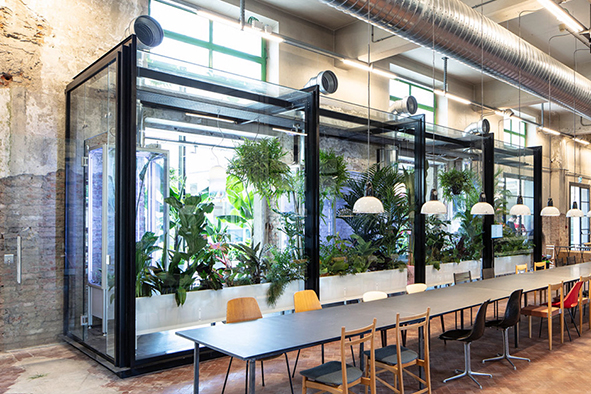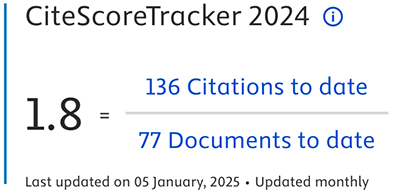Symbiosis of greenery with built form. A holistic, systems, multi-level approach
DOI:
https://doi.org/10.19229/2464-9309/1122022Keywords:
nature-based solutions, green infrastructure, mitigation, resilience, sufficiencyAbstract
Climate change is an effect of human action. It affects the balance of the planet mainly because of the ongoing growth of cities and increased consumption, which leads to the indiscriminate use of non-renewable resources. One solution for this problem is often the use of ‘nature-based solutions’. They can offer many advantages and services for humans and the ecosystem, as long as greenery – ecological per se – is not commoditised, effectively reducing biodiversity and increasing pollution levels. This paper questions the ‘unlimited’ growth model and some uses of greenery in the built form in favour of an approach based on ‘sufficiency’. Holistic and illuminating good practices and experiments in biophilic design, supported by frontier technologies, based on vernacular practices and in collaboration with local communities, are capable of looking at the big picture and tackling the climate challenge in a wider context and at different scales.
Downloads
Article Metrics Graph
References
Ajuntament de Barcelona (2013), Barcelona Green Infrastructure and Biodiversity Plan 2020. [Online] Available at: ajuntament.barcelona.cat/ecologiaurbana/sites/default/files/Barcelona% 20green%20infrastructure%20and%20biodiversity%20plan%202020.pdf [Accessed 12 May 2022].
Block, I. (2019), “Greenery is often ‘sole legitimisation’ for unsustainable buildings says Céline Baumann”, in dezeen, 31/10/2019. [Online] Available at: dezeen.com/2019/10/31/celine-baumann-landscape-architecture/ [Accessed 12 May 2022].
Camps-Calvet, M., Langemeyer, J., Calvet-Mir, L. and Gómez-Baggethun, E. (2016), “Ecosystem services provided by urban gardens in Barcelona, Spain – Insights for policy and planning”, in Environmental Science & Policy, vol. 62, pp. 14-23. [Online] Available at: doi.org/10.1016/j.envsci.2016.01.007 [Accessed 12 May 2022].
de Freitas Netto, S. V., Sobral, M. F. F., Ribeiro, A. R. B. and da Luz Soares, G. R. (2020), “Concepts and forms of greenwashing – A systematic review”, in Environmental Science Europe, vol. 32, article 19, pp. 1-12. [Online] Available at: doi.org/10.1186/s12302-020-0300-3 [Accessed 12 May 2022].
European Commission (2021a), Communication from the Commission to the European Parliament, the Council, the European Economic and Social Committee and the Committee of the Regions – Forging a Climate-Resilient Europe – The new EU Strategy on Adaptation to Climate Change, document 52021DC0082, 82 final. [Online] Available at: eur-lex.europa.eu/legal-content/en/ALL/?uri=CELEX:52021DC0082 [Accessed 12 May 2022].
European Commission (2021b), New European Bauhaus – Beautiful, Sustainable, Together. [Online] Available at: europa.eu/new-european-bauhaus/index_en [Accessed 12 May 2022].
European Commission (2019a), Report from the Commission to the European Parliament, the Council, the European Economic and Social Committee and the Committee of the Regions – Review of progress on implementation of the EU Green Infrastructure Strategy, document 52019DC0236, 236 final. [Online] Available at: eur-lex.europa.eu/legal-content/EN/TXT/?uri=COM:2019:236:FIN [Accessed 12 May 2022].
European Commission (2019b), Communication from the Commission to the European Parliament, the European Council, the Council, the European Economic and Social Committee and the Committee of the Regions – The European Green Deal, document 52019DC0640, 640 final. [Online] Available at: eur-lex.europa.eu/legal-content/EN/TXT/?uri=COM%3A2019%3A640%3AFIN [Accessed 12 May 2022].
European Commission (2014), Building a Green Infrastructure for Europe, Publications Office. [Online] Available at: doi.org/10.2779/54125 [Accessed 12 May 2022].
European Commission (2013), Communication from the Commission to the European Parliament, the Council, the European Economic and Social Committee and the Committee of the Regions – Green Infrastructure (GI) – Enhancing Europe’s Natural Capital, document 52013DC0249, 249 final. [Online] Available at: eur-lex.europa.eu/legal-content/EN/TXT/?uri=CELEX:52013DC0249 [Accessed 12 May 2022].
Faivre, N., Fritz, M., Freitas, T., Boissezon, B. and Vandewoestijne, S. (2017), “Nature-based solutions in the EU – Innovating with nature to address social, economic and environmental problems”, in Environmental Research, vol. 159, pp. 509-518. [Online] Available at: dx.doi.org/10.1016/j.envres.2017.08.032 [Accessed 12 May 2022].
IEEP (2016), The Health and Social Benefits of Nature and Biodiversity Protection – Annex 1 – 20 Case Studies. [Online] Available at: ec.europa.eu/environment/nature/knowledge/pdf/Health%20and%20 Social%20Benefits%20of%20Nature%20-%20case%20studies.pdf [Accessed 12 May 2022].
IPCC – Intergovernmental Panel on Climate Change (2022a), Climate Change 2022 – Mitigation of Climate Change, Switzerland. [Online] Available at: report.ipcc.ch/ar6wg3/pdf/IPCC_AR6_WGIII_FinalDraft_ FullReport.pdf [Accessed 12 May 2022].
IPCC – Intergovernmental Panel on Climate Change (2022b), Climate Change 2022 – Impacts, Adaptation and Vulnerability – Summary for Policymakers, Switzerland. [Online] Available at: ipcc.ch/report/ar6/wg2/downloads/report/IPCC_AR6_WGII_FinalDraft_ FullReport.pdf [Accessed 12 May 2022].
Kohlstedt, K. (2016), “Renderings vs reality – The improbable rise of tree-covered skyscrapers”, in 99% Invisible City, 04/11/2016. [Online] Available at: 99percentinvisible.org/article/renderings-vs-reality-rise-tree-covered-skyscrapers/ [Accessed 12 May 2022].
Moreno, C. (2020), Projet Portes de Paris – Ville du Quart d’Heure Territoire de la Demi-Heure – Transitions Urbaines et Territoriales, Livre Blanc. [Online] Available at: chaire-eti.org/wp-content/uploads/2019/12/Livre-Blanc-2019.pdf [Accessed 12 May 2022].
New European Bauhaus High-Level Round Table (2021), New European Bauhaus Concept Paper, NEB High-Level Round Table, 30 June. [Online] Available at: europa.eu/new-european-bauhaus/high-level-roundtable-visions_en [Accessed 12 May 2022].
Olson, E. (2021), “Plants on Rooftops – Greenwashing in Architecture”, in The Climate Change Review, 08/02/2021. [Online] Available at: ucsdclimatereview.org/post/plants-on-rooftops-greenwashing-in-architecture [Accessed 12 May 2022].
Parker, J. and Zingoni de Baro M. E. (2019), “Green Infrastructure in the Urban Environment – A Systematic Quantitative Review”, in Sustainability, vol. 11, issue 11, 3182, pp. 1-20. [Online] Available at: doi.org/10.3390/su11113182 [Accessed 12 May 2022].
Pawlowska K. and B. Jawecki (2021), “The determination of priority areas for the construction of green roofs with use of the urban valorisation method”, in Sustainability, vol. 13, 13227, pp. 1-24. [Online] Available at: doi.org/10.3390/su132313227 [Accessed 12 May 2022].
Poletto, M. (2018), The Urbansphere – Architecture in the age of ubiquitous computing, Doctoral Thesis, RMTI University. [Online] Available at: researchrepository.rmit.edu.au/esploro/outputs/doctoral/The-Urbansphere-Architecture-in-the-age/9921861966101341 [Accessed 12 May 2022].
Savas, W. (2016), “Green Infrastructure and Urban Biodiversity”, in Landscape Architecture Frontiers, vol. 4, issue 3, pp. 40-51. [Online] Available at: journal.hep.com.cn/laf/EN/Y2016/V4/I3/40 [Accessed 12 May 2022].
Shen, Z., Li, Y., Yang, K. and Chen, L. (2019), “The emerging cross-disciplinary studies of landscape ecology and biodiversity in China”, in Journal of Geographic Science, vol. 29, issue 7, pp. 1063-1080. [Online] Available at: doi.org/10.1007/s11442-019-1645-7 [Accessed 12 May 2022].
Tran, V. V., Park, D. and Lee, Y.-C. (2020), “Indoor Air Pollution, Related Human Diseases, and Recent Trends in the Control and Improvement of Indoor Air Quality”, in International Journal of Environmental Research and Public Health, vol. 17, issue 8, article 2927, pp. 1-27. [Online] Available at: doi.org/10.3390/ijerph17082927 [Accessed 12 May 2022].
UN – United Nations (2022), Goal 11 – Make cities inclusive, safe, resilient and sustainable. [Online] Available at: unric.org/en/sdg-11/ [Accessed 12 May 2022].
UN Environment and IEA – International Energy Agency (2017), Global Status Report 2017 – Towards a zero-emission, efficient and resilient buildings and construction sector. [Online] Available at: unep.org/news-and-stories/story/buildings-and-construction-sector-grows-time-running-out-cut-energy-use-and [Accessed 12 May 2022].
Valenti, A. and Pasquero, C. (2021), “La seconda vita dei micro organismi – Il design biodigitale per una nuova ecologia dello spazio e del comportamento | The second life of micro-organisms – Bio-digital design for a new ecology of space and behaviour”, in Agathón | International Journal of Architecture, Art and Design, vol. 9, pp. 42-53. [Online] Available at: doi.org/10.19229/2464-9309/942021 [Accessed 12 May 2022].
Xing, Y., Jones, P. and Donnison, I. (2017), “Characterisation of nature-based solutions for the built environment”, in Sustainability, vol. 9, issue 1, 149, pp. 1-20. [Online] Available at: doi.org/10.3390/su9010149 [Accessed 12 May 2022].
Ying, J., Zhang, X., Zhang, Y. and Bilan, S. (2021), “Green infrastructure – Systematic literature review”, in Economic Research – Ekonomska Istraživanja, pp. 1-24. [Online] Available at: doi.org/10.1080/1331677X.2021.1893202 [Accessed 12 May 2022].
Zhang, K. and Chui, T. F. M. (2019), “Linking hydrological and bioecological benefits of green infrastructures across spatial scales – A literature review”, in Science of the Total Environment, vol. 646, pp. 1219-1231. [Online] Available at: doi.org/10.1016/j.scitotenv.2018.07.355 [Accessed 12 May 2022].

Downloads
Published
How to Cite
Issue
Section
License
This Journal is published under Creative Commons Attribution Licence 4.0 (CC-BY).
License scheme | Legal code
This License allows anyone to:
Share: copy and redistribute the material in any medium or format.
Adapt: remix, transform, and build upon the material for any purpose, even commercially.
Under the following terms
Attribution: Users must give appropriate credit, provide a link to the license, and indicate if changes were made; users may do so in any reasonable manner, but not in any way that suggests the licensor endorses them or their use.
No additional restrictions: Users may not apply legal terms or technological measures that legally restrict others from doing anything the license permits.
Notices
Users do not have to comply with the license for elements of the material in the public domain or where your use is permitted by an applicable exception or limitation.
No warranties are given. The license may not give users all of the permissions necessary for their intended use. For example, other rights such as publicity, privacy, or moral rights may limit how you use the material.

















































































